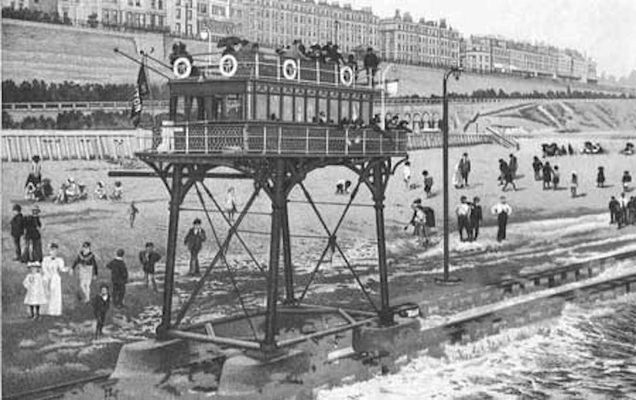About
Magnus Volk is Brighton’s equivalent of Nikola Tesla. Not content with having the first electrified house in Brighton (a task he took upon himself), in 1883 he unveiled the Volk’s Electric Railway along Brighton seafront. The railway continued to expand along the coast and proved very popular with tourists.
However in 1892, Volk cast his eyes towards Rottingdean, a small village three miles to the east of Brighton. To extend his existing railway would require either a steep climb to the cliff top or a building a viaduct along the unstable undercliff. Not keen on either option, Volk turned his mind to building a completely new railway that would travel through the sea.
So in 1894, work began on the Seashore Electric Railway which involved building a railway across the intertidal rock pools between Brighton and Rottingdean. At 18-feet wide, the railway still holds the record for being the widest railway ever built. Why did it have to be so wide? Because along the railway, would go "Pioneer," a 45-ton “salt-water tram” supported on 23-feet high struts allowing it to run through the water. With its gangly appearance, Pioneer quickly earned the nickname of “The Daddy Long Legs.”
The Seashore Electric Railway open on November 28th 1896 but less than a week later, a storm hit. Crashing waves destroyed Brighton’s Chain Pier, badly damaged the original electric railway and all but wrote off Volk’s new enterprise. Pioneer had broken free from her moorings and trundled out to sea to be exposed to the full force of the storm. By morning, she lay on her side, broken almost beyond repair. While in the shop, Volk took the opportunity to extend Pioneer’s legs by two feet and the railway reopened in the summer of 1897, proving extremely popular, with passengers being able to take in the sea air without the fear of "mal de mer." However, it would be Brighton’s sea defences that would eventually put Pioneer to bed.
Two new groynes had started to cause scouring of the seabed which damaged the trackbed. Repairs caused Volk to close the line for several weeks during the height of the summer. Then in September 1900, Volk was informed that he would have to divert his line around the new sea defences being planned along the cliffs. This would involve moving into much deeper water and even further investment. In January 1901, parts of the track that were in the way of the sea defence construction were simply removed, ceasing operations immediately.
No longer required, Pioneer was strapped to a pier and left. With no rush to remove it, the tram remained in place, gently rusting away until 1910 when the remnants of the railway were sold for scrap, much of it going to Germany where it was no doubt used in munitions and fired back at English troops four years later.
While Volk’s Electric Railway is still in operation today (making it the world’s longest operating electric railway), very little remains of the Seashore Electric Railway. All that is left is a trail of concrete piles that become exposed at extreme low tides.
Related Tags
Know Before You Go
The tracks start immediately east of Brighton Marina. Can only be seen at low spring tides.
Published
September 30, 2015































